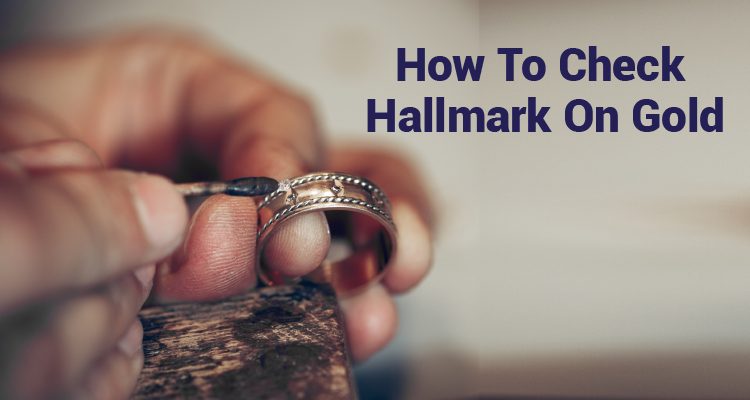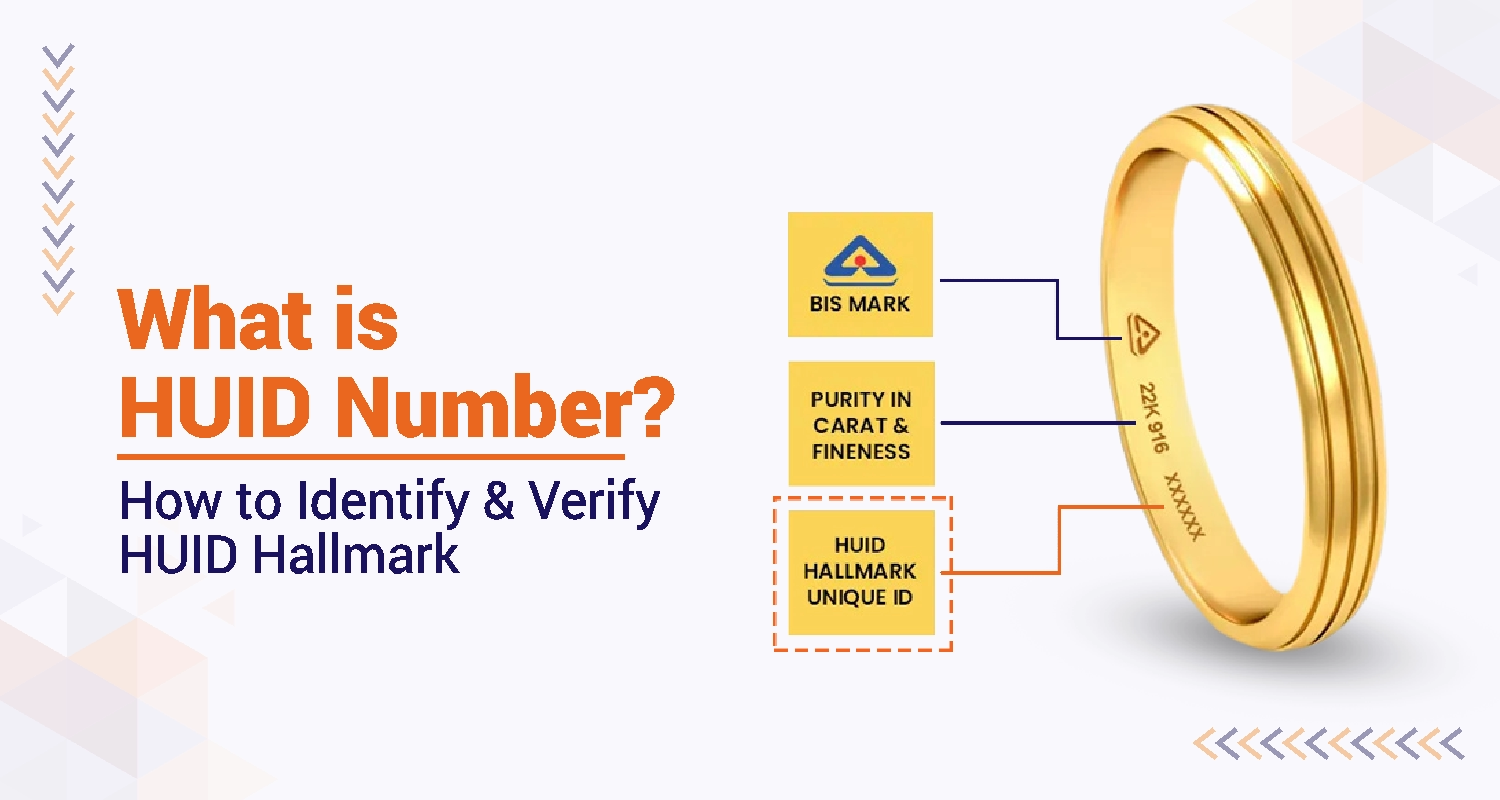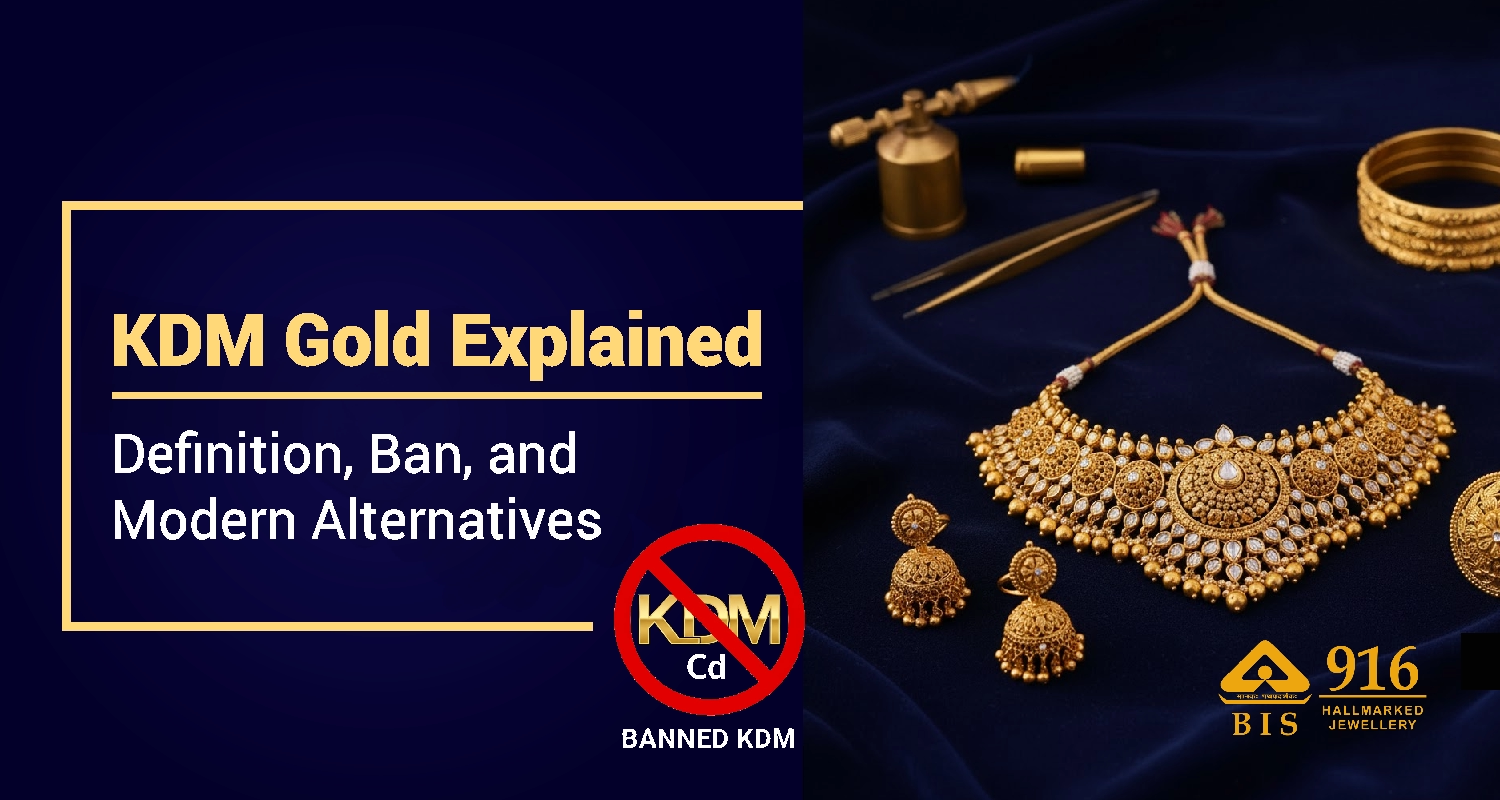Hallmark Gold in India: How to Check Hallmark on Gold

In India, hallmark gold is a certified assurance of purity, tested and verified by the Bureau of Indian Standards (BIS). As gold continues to serve both as a cherished asset and collateral for loans, especially from NBFCs, buyers and borrowers alike need to know how to check the hallmark on gold, both physically and through gold hallmark check online tools. After all, in a market glittering with options, distinguishing between genuine and adulterated gold can make all the difference in protecting your investment.
Even though big brand names and trusted jewellers are common, cases of impurities and misrepresentation aren’t uncommon. To address this, the BIS has made it mandatory for jewellers to sell only hallmarked gold items, each bearing a unique 6-digit Hallmark Unique Identification Number (HUID). But how do you, as a buyer, ensure your gold is genuinely hallmarked and authentic?
Here’s a simple guide on how to verify gold hallmarks and make your purchase or for that matter, a gold loan, safe and smart.
What is the Hallmark of Gold?
Hallmarking is the official certification of gold purity, carried out by the Bureau of Indian Standards (BIS)—the only authorised agency in India. It ensures that the gold used in jewellery or artefacts meets the declared karatage.
Since June 23, 2021, hallmarking has been mandatory for 14K, 18K, 22K, and 24K gold across districts with BIS-assaying and hallmarking centres. As of 2025, mandatory hallmarking applies in 343 districts, following phased regulatory expansions by the Government of India.
Each hallmarked gold item carries a 6-digit Hallmarking Unique Identification (HUID) number, issued only after purity testing at BIS-recognised centres. This system protects buyers from fraud and ensures consistent gold quality nationwide.
Following the introduction of the six-digit alphanumeric code in July 2021, the three marks for gold jewellery/artefacts followed by the BIS are a BIS logo, purity/fineness symbol, and a six-digit alphanumeric code.
- BIS logo - The BIS logo is symbolised by a triangle. It means that the purity of the jewellery has been verified in one of the licensed labs of BIS.
- Purity/Fineness - This mark stands for the purity of gold used in making the jewellery. As gold comes in varying grades of purity, it is important for a customer and is a healthy business practice to be fair and transparent. The purity mark enables customers to know that they are getting the jewellery of a specified purity level.
- 6-digit alphanumeric code - This is the Hallmark Unique Identification number or HUID, which is a mandatory mark on gold jewellery, particularly at the time of sale. The HUID number is given at a BIS-certified Assaying and Hallmark centre. It offers a distinct identity to gold jewellery and also makes it traceable.
The standard hallmark engraved on the gold jewellery should have the following:
Each gold hallmark in India includes specific symbols that confirm its purity, origin and official BIS certification.
BIS logo:
The logo is triangular in shape and assures that the gold article has been produced in a facility with BIS certification. A BIS logo indicates that the gold meets the quality standards.
Purity/Fineness Mark ():
This indicates the purity of gold. The purest form of gold is 24 carats, which is 99.99% pure. Most jewellery in India is made of purity between 14K and 22K. Thus, the figures 22K916 stamped on the gold indicate that the article is made of 22K gold or has a gold content of 91.6%. The figure 14K585 indicates that the article is made of 58.5% gold, while the remaining consists of other metals.
HUID Number:
This is a unique 6-digit alphanumeric code on each article of gold sold. Prior to April 01, 2023, there was only a four-digit code. The new regulations in place make a six-digit HUID mandatory, making it possible to trace the gold article to the original jeweller who has hallmarked it and the original assaying centre. As a customer, you can download and use the BIS Care App to help verify the HUID. The Verify HUID option allows you to enter the HUID number. If the number is genuine, it will be reflected in the app.
How to Check Gold Hallmark Online Using the BIS Care App
Here’s how you can download and use the app -
Step 1: Download and Install
- Open the App Store: Go to the Google Play Store on Android devices or the Apple App Store on iOS devices.
- Search for the App: Type "BIS Care App" in the search bar.
- Download and Install: Select the app from the search results and tap "Install" to download and install it.
Step 2: Register/Login
- Open the App: Once installed, open the BIS Care App.
- Register: Enter your name, mobile number, and email address.
- Verify OTP: Receive and enter the OTP sent to your mobile number and email to complete the registration.
Step 3: Verify HUID
- Home Screen: On the app's home screen, locate the "Verify HUID" option.
- Tap on Verify HUID: Select this option to proceed with verifying the hallmarking of your gold jewellery.
Step 4: Enter HUID Number
- HUID Input Field: You will be directed to a screen where you can enter the HUID number.
- Enter HUID: Type the six-digit alphanumeric HUID number found on your gold jewellery.
- Search: Tap the "Search" button to proceed.
Step 5: View Details
Verification Results: The app will display detailed information about the gold jewellery, including:
- Jeweler's Registration Number
- Assaying and Hallmarking Centre (AHC) Details
- AHC Registration Number
- AHC Address
- Article Type
- Date of Hallmarking
- Purity
Additional Features of the BIS Care App
- Verify Licence Details: Check the authenticity of products with ISI marks.
- Know Your Standards: Access information on Indian standards and related licenses.
- Complaints: File complaints regarding product quality or misuse of BIS marks.
- Locations of BIS Labs and Offices: Find nearby BIS facilities.
Types of Main Hallmarks
There are two main types of Hallmarks on gold jewellery as follows:
Stamps: The traditional type of hallmarking, stamps were put on gold jewellery as a way of Hallmarking. However, it wasn’t the ideal method, as it would cause the jewellery piece to deform if the jewellery was delicate or hollow. Also, if the piece of jewellery was old, it would wear down, and the Hallmark stamp would show on the outside.
Laser: A modern development over the traditional method of using stamps to hallmark, modern manufacturers now choose laser Hallmark for the purpose. It is superior over stamping, in that it does not disfigure the jewellery. The Hallmark is generally subtle and visible only using a jeweller’s loupe. However, an inherent drawback of this method is, when a piece of jewellery needs sizing. In the process of resizing, the Hallmark can be polished out and needs to be returned to the Assay office to restore the Hallmark.
How to Read Gold Hallmarkings?
Every hallmarked gold item carries three key components, namely the BIS logo, the purity/fineness mark (karatage), and a six-digit alphanumeric HUID. These markings verify the authenticity and quality of your gold, ensuring it meets BIS standards and is legally certified.
|
Karat |
6 Digit Alphanumeric HUID |
Gold Content |
Details |
|
14K |
14K585 |
58.50% |
Durable, budget-friendly gold |
|
18K |
18K750 |
75% |
Common in jewellery, moderate purity |
|
20K |
20K833 |
83.30% |
Less common, seen in vintage jewellery |
|
22K |
22K916 |
91.60% |
Most popular for Indian gold jewellery |
|
23K |
23K958 |
95.80% |
High-purity, less commonly used |
|
24K |
24K999 |
99.90% |
Purest form, used in coins/bars, not durable |
How to Physically Check Hallmark on Gold Jewellery
Here’s a step-by-step flowchart illustrating how to check a hallmark on Gold Jewellery:
- Look for the BIS Logo → Ensures government-certified authenticity
- Check the Purity Mark → Confirms gold’s karat value (e.g., 22K, 18K)
- Verify the HUID Number → A unique 6-digit alphanumeric code
- Use the BIS Care App → Scan and confirm the gold’s certification
- Consult a Jeweler (if needed) → Seek expert verification
Red Flags: Signs of a Fake Hallmark
Even with hallmarking in place, counterfeit gold still circulates in the market. Here are some common signs that can help you spot a fake hallmark:
- Blurred or Uneven Markings: Genuine hallmarks are crisp and clear. Fake hallmarks often appear smudged, blurry, or unevenly stamped.
- Missing Elements: A legitimate hallmark will always have the BIS logo, purity mark, and HUID number. If any of these elements are absent, it’s a strong indication of fraud.
- Conflicting Signs: The purity mark should match the gold’s overall look. If a piece that appears to be 24K gold is marked as 18K, for example, there might be a problem.
- Strange Markings: If you spot the hallmarking that looks odd than the standard BIS hallmarks, be cautious. Some fraudulent dealers would also add symbols or change the markings.
Why Hallmark Gold Matters (For Buyers and Gold Loans)
Since gold comes in various purities and isn’t distinguishable by eye, buyers often risk overpaying for substandard gold. Hallmarking, mandated by the Bureau of Indian Standards (BIS), ensures certified purity—building trust and transparency in the gold market. Here’s why it’s important:
- Better Resale Value: Hallmarked gold commands higher resale prices. Its certified purity ensures no deductions or disputes during resale.
- Higher Gold Loan Value: Lenders offer better loan amounts and interest rates against hallmarked gold, as its purity is guaranteed.
- Consumer Protection: If purity is misrepresented, buyers can file complaints with BIS and consumer forums for resolution.
- Confidence in Buying & Recycling: Hallmarked gold can be bought or exchanged with confidence—no need for additional purity tests.
It can be incredibly upsetting to find out your gold is not real, but taking the proper steps can get you on the right track to a solution. These are the actionable steps you can take if you suspect fake gold, allowing you to protect your rights and recover your loss.
Contact the Jeweller
If you also become convinced that the gold you bought is not real, the first step is to contact the jeweller. Show them any proof of purchase (the bill or certificate of authenticity) and let them know your concerns. Many reputable jewellers should work with you to resolve the issue, either with their own assessment or offering a refund or exchange.
Get a Professional Assessment
If you're unsure if the gold is fake, you should go to a certified gold assayer or testing centre to have it checked. These experts employ methods such as X-ray fluorescence (XRF) or acid testing to accurately gauge the purity of the gold. If the hallmark seems questionable, you can also get it verified at a BIS-recognised hallmarking centre.
File a Complaint with BIS and Consumer Protection Authorities
If you test the gold and find that it is impure, and if the jeweller does not take any responsibility, then you can take some steps. Log in to the Bureau of Indian Standards and register a complaint online as it is the body that monitors the hallmarking of gold in India. You can also contact consumer protection agencies about fraudulent activity. Many sites allow you to file complaints online so that they can be resolved more quickly.
Seek Legal Advice
If the jeweller maintains its position, consult a lawyer to look at legal recourse. You might be entitled to compensation based on the level of the fraud. It also helps keep fraudulent sellers accountable and protects other potential buyers from falling for their ruse.
Impact of Hallmarking on Gold Loans
Gold loans are a popular financial tool in India, offering quick access to cash by pledging gold as collateral. However, the purity of the gold plays a crucial role in determining the loan amount and eligibility. This is where hallmarking comes into the picture.
1. Increased Loan Eligibility
Banks widely prefer hallmarked gold and non-banking financial companies (NBFCs) because they come with a certified guarantee of purity. Since lenders determine loan amounts based on the weight and purity of the gold, having a hallmark assures them that they are offering a loan against genuine gold.
2. Higher Loan Amounts
Since hallmarking certifies the authenticity and purity of gold, lenders are more confident in offering higher loan amounts. Typically, gold loans are sanctioned at 75% of the gold's market value (as per RBI guidelines). With hallmarked gold, lenders are more likely to offer the maximum loan-to-value (LTV) ratio, ensuring that borrowers receive the best possible amount for their pledged gold.
3. Faster Loan Approvals
Non-hallmarked gold often requires additional purity testing before a loan can be sanctioned, which can delay the loan approval process. Hallmarked gold, on the other hand, does not require extensive verification, allowing borrowers to get their loans processed much faster.
4. Mandatory Requirement for Some Lenders
Certain financial institutions have made hallmarking a mandatory requirement for sanctioning gold loans. Without a valid hallmark, borrowers may either face loan rejection or be offered a lower loan amount due to doubts about the purity of their gold assets.
Conclusion
Gold is a valuable asset, and ensuring its purity is crucial for buyers. A sales receipt confirms the transaction, but only hallmarking guarantees authenticity. Always check for the BIS logo, the purity mark, and the 6-digit HUID when purchasing gold. Additionally, you can verify the hallmark using the BIS Care App for added security. By following these steps, you can confidently invest in genuine gold, safeguarding your wealth for the future.
Sapna aapka. Business Loan Humara.
Apply NowFrequently Asked Questions
Ans. Yes, 22K gold is the same as 916. The figure 916 denotes the percentage of the purity of gold, which in this case is 91.6% pure gold and 8.4% other metals like copper and silver.
Ans. 916 hallmark indicates 22-karat gold, meaning it contains 91.6% pure gold and 8.4% alloy. It is not 24K, which is 99.9% pure.
Ans. 916 KDM refers to 22K gold soldered using cadmium (KDM). While it was once popular, cadmium is now banned due to health concerns. BIS hallmarking is the safer standard today.
Ans. 875 gold refers to 21K gold, containing 87.5% pure gold and 12.5% alloy. It is less common in India but used in some international jewellery standards.
Ans. 999 gold is purer than 916. While 916 is 22K gold (91.6% pure), 999 denotes 24K gold, which is 99.9% pure, typically used in coins and bars, not jewellery.
Ans. 750 gold is 18-karat gold, consisting of 75% pure gold and 25% alloy. It offers a good balance between purity, durability, and cost, widely used in fine jewellery.
The gold loan calculator uses gold’s purity and weight to compute eligibility, and hallmarked gold guarantees the purity value for a more reliable estimate.
Disclaimer : The information in this blog is for general purposes only and may change without notice. It does not constitute legal, tax, or financial advice. Readers should seek professional guidance and make decisions at their own discretion. IIFL Finance is not liable for any reliance on this content. Read more



